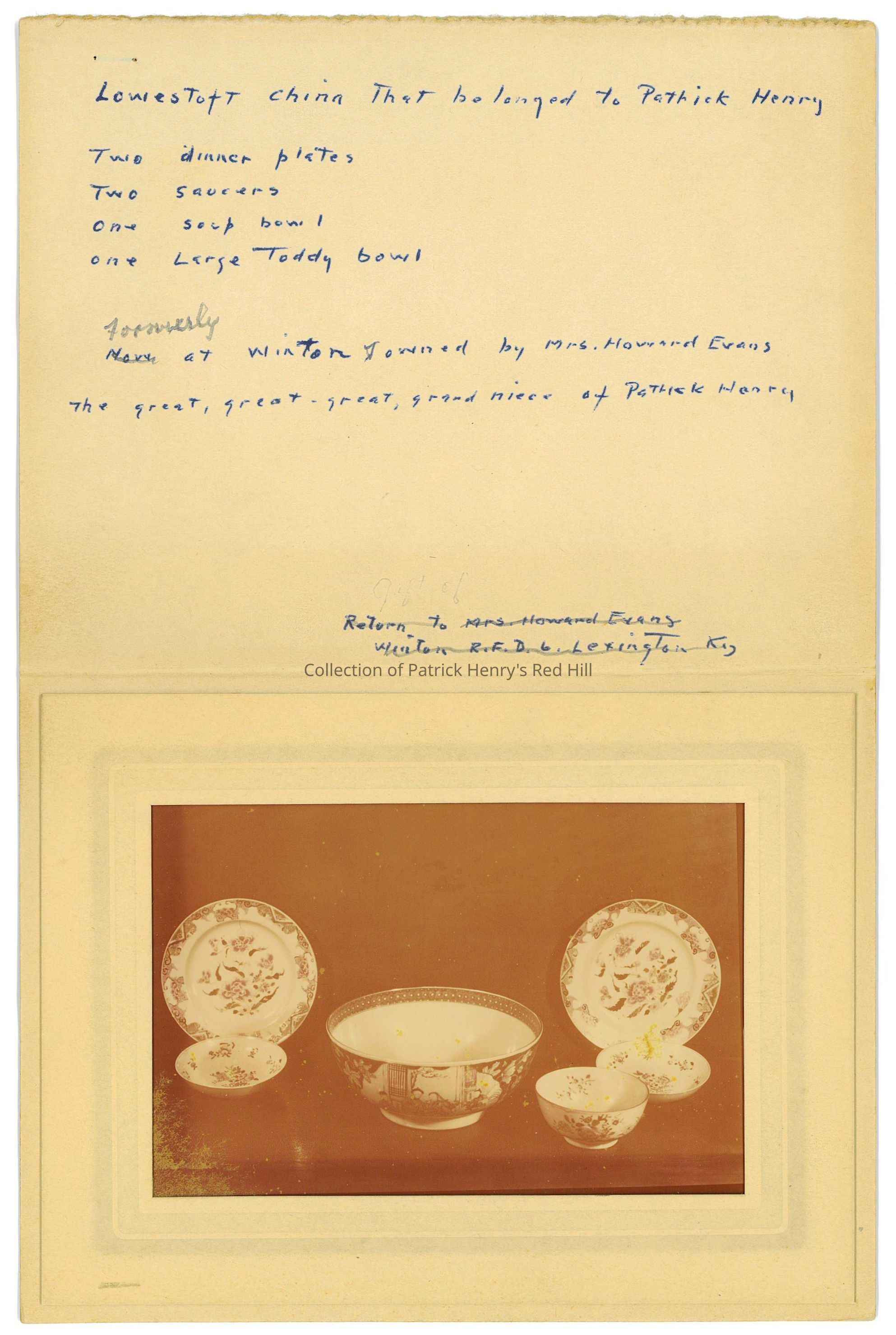Name/Title
Lowestoft China That Belonged to Patrick HenryEntry/Object ID
2020.11Description
Black-and-white photograph with a sepia tone and glossy texture of a six-piece Lowestoft china set. On the left and resting vertically against the back is a large white plate with a decorated outer rim and a flower and leaf design in the middle. In front of this horizontally sits a small saucer dish with what appears to be, from view, at least six individual floral motifs encircling its edge with a large floral design in the bottom middle. Towards the middle of the photo sits the largest piece, a bowl with a white base with a decorated rim and, from view, a plain inside. The outer sides of the bowl are decorated with images of four people next to a building, flanked on either side with flowers.
To its immediate right sits, slightly more forward at a diagonal, a smaller bowl with a similar white base. This bowl appears to have a thin line painted around the rim, and the inside is mostly plain with, from view, at least one floral motif. The outside of this bowl is decorated with a larger, more detailed floral design. Diagonally behind sits another small saucer dish identical to the first one. Behind this, and also resting on its rim vertically against the back, sits a large white plate identical to the first one, creating symmetry in the image.
The photograph is placed behind a cardstock frame attached to the bottom half of a card. Handwritten notes in the hand of Dr. Robert Meade are on the opposite page.
Transcription:
Lowestoft China that belonged to Patrick Henry
Two dinner plates
Two saucers
One soup bowl
One Large Toddy bowl
Now [struck, "Formerly" written above in pencil] at Winton, [struck, "&" written over in pencil] owned by Mrs. Howard Evans
The great, great-great, grand niece of Patrick Henry
Gift of
Return to Mrs. Howard Evans [struck]
Winton R. F. D. 6. Lexington Ky [struck]
The outside of the card has a gray marbled design present on both sides of the card. On the backside at the bottom is the photo publishing company's identification.
Transcription:
PAVELLE COLOR PRINT
PAVELLE LABORATORIES, INC. 16 EAST 42ND. ST. NEW YORK 17, N.Y.
MADE ON Ansco COLOR PRINTONMade/Created
Date made
1944 - 1954Notes
OriginalProvenance
Notes
This photograph depicts a six-piece Lowestoft china set that, according to tradition, belonged to Patrick Henry.
At Henry's death in 1799, some of his belongings were given to his sister, Jane Henry Meredith (1737–1819), who lived with her husband, Colonel Samuel Meredith Jr. (1732–1808) at Winton in Amherst County, Virginia. Jane Meredith's son, Major Samuel Meredith III (1765–1825), inherited the set. Major Meredith lived in Kentucky near what is now Lexington. Major Meredith named his Kentucky home Winton after his father's home in Virginia.
This photograph was taken prior to the sale of several items tied to Patrick Henry and his family on March 27, 1968 by James Howard Evans (1895–1969) at Winton in Kentucky, near Lexington. His wife, Catherine Peter Evans (1895–1964), was a third-great-grandniece of Patrick Henry. These items were:
- Pair of mourning bracelets containing Patrick Henry's hair
- Bracelet clasp memorial to William Henry (76.6.2)
- Six-piece Lowestoft china of Patrick Henry's
- Mourning ring containing Sarah Henry's hair (76.6.3)
- Marble table top owned by Lord Dunmore
- Dorothea Dandridge Henry's English guitar (76.6.1)
- Jane Henry Meredith's prayer book (76.21.1)
- Portrait in oil and miniature portrait in watercolor painting of Major Samuel Meredith III.
The china set was purchased at this sale by the Association for the Preservation of Virginia Antiquities, now Preservation Virginia. Many other items were purchased at a later time by PHMF.
This photo was developed by Pavelle Laboratories in New York, New York sometime in the 1940s or 1950s. Pavelle Laboratories, Inc. was a part of a conglomerate of photofinishing suppliers in New York and began operations in 1934. The back of the card indicates that this photo was printed after the creation of Ansco Color Printon, which was developed in March 1944 by the firm Ansco. Printon, being a material on which positive-transparency color film could be printed.
The photograph was pulled from the papers of Robert Meade (76.65) and accessioned on September 7, 2020 due to historical significance.
